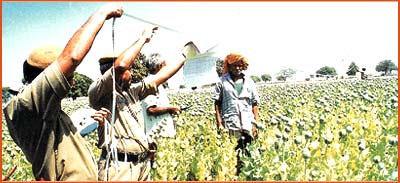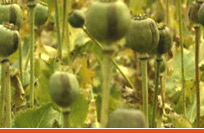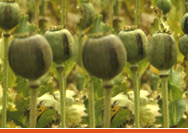

The
first recorded history of poppy cultivation in India in the 15th Century
refers Cambay and Malwa as the places where it was grown. During the
Mughal Empire, poppy was extensively grown and it was an important
article of trade with China and other Eastern countries. During the
later part of the 16th Century, opium was brought under a State
monopoly. However, during the twilight years of the Mughal Empire, the
State lost its hold and control over the production and sale of opium
was appropriated by a ring of merchants in Patna. In 1757, the monopoly
of the cultivation of poppy passed into the hands of the East India
Company who had by that time assumed the responsibility for collection
of revenue in Bengal and Bihar. In 1873, the then Governor General, Lord
Warren Hastings brought the entire opium trade under the control of the
Government.
Under the East India Company and afterwards under the British rule,
unrestricted cultivation of the poppy and the production of opium were
prohibited. The present structure of licit poppy cultivation and
production of opium in India under a regular system of control thus
dates back to the beginning of the nineteenth century. Although some
changes took place over the years in the methods of control ,
production, distribution, sale and possession of opium, the monopoly
remained solely in the hands of the Government.


After
India gained independence in 1947, the control over cultivation and
manufacture of opium became responsibility of the Central Government
with effect from 1st April, 1950. By virtue of the Opium and Revenue
laws (Extension of Application) Act 1950, the three Central Government
enactments, viz. the Opium act 1857, the Opium Act 1878 and the
Dangerous Drugs Act of 1930, became uniformly applicable in all the
States of Indian Union.
At present the Narcotics Commissioner along with the subordinates
exercises all powers and performs all functions relating to
superintendence of the cultivation of the opium poppy and production of
opium. The Commissioner derives this power from the Narcotic Drugs &
Psychotropic Substances Act 1985 and Narcotic Drugs & Psychotropic
Substances Rules, 1985. License for manufacture of certain types of
narcotic drugs and psychotropic substance as well as permits for export
and import of narcotic drugs, psychotropic and controlled substances are
issued with the the approval and permission of the Narcotics
Commissioner.
The Government of India announces the licensing policy for cultivation
of opium poppy every year, prescribing, interalia, the minimum
qualifying yield for issue of or renewal of licence, maximum area that
can be cultivated by an individual cultivator, the maximum benefit that
can be allowed to a cultivator for damage due to natural causes, etc.
The opium poppy can be cultivated only in such tracts as are notified by
the Government. At present these tracts are confined to three
States,viz. Madhya Pradesh, Rajasthan and Uttar Pradesh. Mandsaur
district of Madhya Pradesh and Chittorgarh and Jhalawar Districts of
Rajasthan constitute about 80% of the total area cultivated.
A miracle of nature and India's gift
to the world, opium is unique in its therapeutic value and is
indispensable in the medical world. It also finds use in Homeopathy and
Ayurveda or Unani systems of indigenous medicines. The opium which is
used as Analgesics, Anti-Tussive, Anti spasmodic and as a source of
edible seed-oil, also acts as a medicinal herb.






